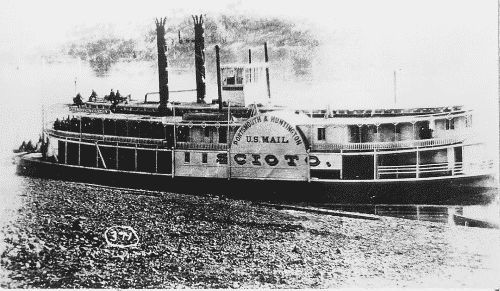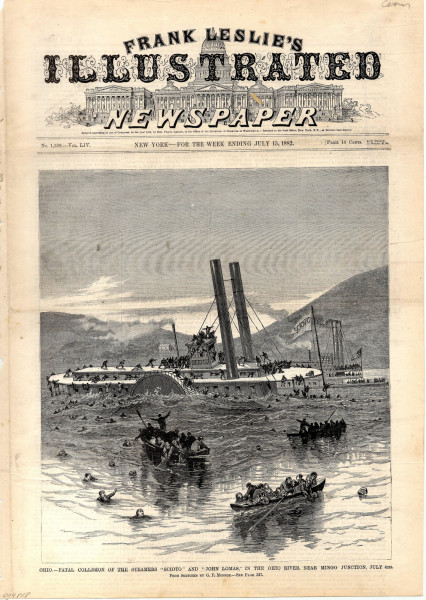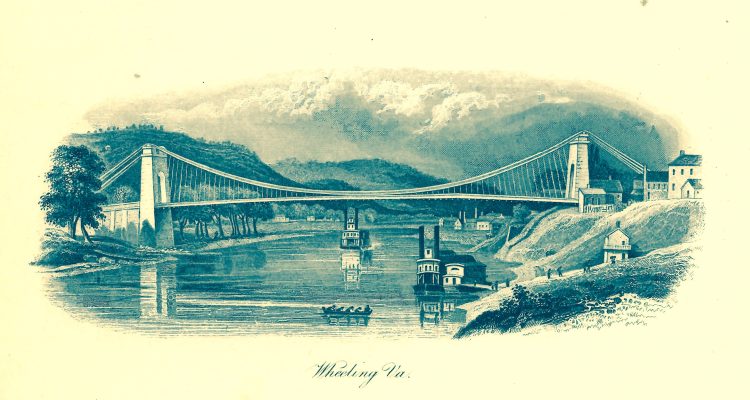Note: This is a fictional tale. Rich Knoblich, WV storyteller and a regular winner of the Liar Contest at the annual Vandalia Gathering hosted by the WV Dept. of Arts and Culture, likes to add some drama, mystery and fun to his fables. It’s been said that some of the best lies are ones that are weaved with a thread of truth, which is exactly how Knoblich designs his short stories. Can you spot the truth in this tale?
By Rich Knoblich
Weelunk Contributor
Dating back to the placement of a skull, aka Weelunk, along the Ohio River’s banks, Wheeling’s folk history has evolved to include numerous paranormal events based on factual events. Many occurrences have been documented and are passed along as part of the backdrop that makes up Wheeling’s ethos.
Newspaper articles documenting the tragedy of the Steamboat Scioto can be found at Chronicling America for July 5, 1882.
http://chroniclingamerica.loc.gov
Here is an example of our magnificent ghostly folk history:
Eventually, passenger railroads and some freight gave way to the highway system. Unnecessary railroad tracks fell into disrepair and were abandoned. But once the tracks were removed, the wide level property became part of the adaptive use movement as biking/hiking trails stretch for miles along what is now considered to be a pleasant scenic riverfront. Wheeling’s Heritage Port is an example of the aesthetics of riverfront development.
Gone also is the Pennsylvania Railroad Depot with only its base stone skeleton remaining. The red brick flooring, arched windows, and wide doorframe remain to baffle joggers, cyclists, and hikers who are unaware of its past usage.
It was near this old depot location that I paused one day while walking along the rails-to-trails path. A shoelace had come loose, and I took advantage of a bench that sat facing the Ohio River to tighten it. At one end of the bench sat an elderly fellow, and I must admit I was impressed that he was still out on the trails getting his daily exercise outdoors. We started the usual casual conversation between strangers in close proximity like one does in an elevator.
When I stood up from tying my shoelace my cell phone alerted me to a text message. I pulled the phone out of my pocket and was surprised to see it displayed a series of periods and hyphens.
“Huh,” I muttered, “Look at that.” I showed him the strange encryption. “Weirdest butt dial I’ve ever gotten.”
“Not so strange.” he replied after a quick glance. “Considering the history of this spot.” He threw a thumb over his shoulder at the depot remains. “I’ve had it happen to me and have had others mention it in previous conversations.”
“What do you mean?” I asked.
“That’s Morse Code on your phone, the earliest form of texting. It spells out a specific message for a reason,” he said.
I looked closely at my iPhone’s screen. With my rudimentary knowledge we learn as children SOS was dot dot dot, dash dash dash, dot dot dot. I could make out the initial ‘S’ and the ending ‘O’ on the short transcript.
“Can you read this?” I asked holding the screen up to him.
“Don’t need to see it to know it spells out S-c-i-o-t-o,” he replied.
“How do you know?” I asked suspicious of the odd word. I made a mental note to look up Morse Code in Wikipedia when I got home to verify his comment.
“Not my first rodeo,” he answered. “Would you like to hear the whole story? It’s short”

Always up for good conversation I agreed to listen.
He started with a sweep of his arm to direct my eyes to encompass the Ohio River as it flowed past. I gazed out over the brown waters, the setting for his tale.
“It occurred back in 1882 during a July 4th riverboat excursion. Even back then people enjoyed day trips on steamboats. The Scioto was a sidewheeler. Its holiday crowd boarded at Wellsville, Ohio, located across the tip of the northern panhandle of the state of West Virginia.
“It was a trip that arrived at the Moundsville dock at two in the afternoon. People disembarked and walked up the gently sloping street to tour the Grave Creek Mound and view the gothic crenelated fortress of the West Virginia State Penitentiary across the street to the east.
“Pilot David Keller also got off and made his way up the street stopping in at his favorite tavern for a quick cool beer and a chat with his barkeeper friend. After a couple of hours the steamboat blasted its whistle to gather the passengers back to the Scioto and then started its merry journey back up the Ohio.
“Although licensed for less than 60 passengers, the Scioto’s crew, with no other cargo, allowed over 500 paying customers onto the vessel. The steamboat was so heavily overloaded that the captain instructed the crew not to allow too many people onto the third level hurricane deck for fear of capsizing. With a full load the steamboat continued past customers along river towns who hailed it for passage as was the custom. As events unfolded they must have related to friends about their close call with death.
“The return trip to Wellsville was going smoothly until about 8 p.m. At a bend in the river near Mingo Junction, across from Short Creek, the Scioto encountered the John Lomas steamboat descending the Ohio.
“Carried by the current, the descending John Lomas had the right of way for passage — a single whistle for the Ohio side of the river or two whistles for the West Virginia side. The John Lomas gave its intentions late with a single whistle, and the Scioto acknowledged with two whistles. The John Lomas then repeated two whistles causing confusion as to its intended path.
“Spectators, sitting out on porch swings during the warm summer evening, a full moon overhead, watched two majestic steamboats traveling along the channel. It became clear to those on shore that disaster was about to occur because of the close proximity of the steamboats. Farmers ran to their skiffs and set out for the inevitable rescue mission.
“Captain Keller of the Scioto ordered full reverse. Caught by the current, the boat swung in a slow pivot toward the Ohio shore. The captain of the John Lomas also ordered a full reverse but the steamboats were too close. The Scioto was broadsided by a direct hit from the bow of the rapidly moving John Lomas. A hole was torn into the side of the Scioto. In only three minutes it sank into 15 feet of water taking its passengers down into the dark waters.

“Rescue operations were undertaken immediately. The John Lomas, only slightly damaged, pulled to the Ohio shore, and passengers quickly disembarked. It then returned to the river and began searching for passengers that had fallen or leaped into the night waters. Along with the people rowing skiffs from the West Virginia shore, many were saved, but not all.
“Word spread to Wheeling about the disaster upstream, and officials took action. At close to midnight a train engine from the P. W. & Ky RR (Pittsburgh, Wheeling, & Kentucky Railroad) was dispatched from the Pennsylvania depot at the north end of Water Street with people hoping to lend assistance. With them were reporters and Manager Tracy of the Western Union Telegraph office. The manager carried special equipment to tap into the telegraph wires located along the rail line. Soon after the manager’s arrival, a rapid staccato of information started pouring into Wheeling’s Pennsylvania Depot telegraph station, where runners quickly took the transcriptions and delivered them to the nearby newspaper.
“Accounts of the mishap were relayed by Manager Tracy. He reported deeds of bravery, listened to sobbing rescuers tell of hapless cries in the dark that were soon stilled, and sent lists of survivors and the names of confirmed deaths including that of Captain Keller’s 10-year-old son, Dan Keller. The news was tapped out in rapid staccato dits and dahs as the telegraph manager worked through the night. He listened to gut-wrenching accounts of eyewitnesses describing seeing panic-stricken faces disappearing into the water before they could be saved. The telegraph operator never broke or wavered as he conveyed the crushing news that needed to be relayed to anxious relatives up and down the river.
“Later that year Scioto Pilot David C. Keller was indicted under federal law. Enacted 44 years earlier in 1838 the Steamboat Inspection Service Law, one of the first laws of federal regulation allowed for the prosecution of officers.
“The defense pointed out that a new navigation law had taken effect only a few days before the accident. The new procedure was contrary to former approaches on that stretch of the river and added to the confusion. Coupled with the John Lomas’s captain waiting much too long to signal his intent, the jury had to find Captain Keller innocent. Also, the bartender in Moundsville testified that the captain had only one drink and was not inebriated as the prosecution contended. The trial ended in a hung jury.
“The captain was retried and convicted in February of 1884. The trial was so sensational that a gag order was in effect to prevent the newspapers from inflaming public opinion. Captain Keller was found guilty, fined $500, and sentenced to two years in jail. He was pardoned by President Grover Cleveland because knowledgeable riverboat pilots were vital to commerce. Keller regained his pilot’s license and resumed work on the river for many years.
“It was reported that after all was said and done, nobody was held accountable for the 70 people that lost their lives that day.”
The elderly gentleman turned to me sitting there on the bench.
“You see that’s why the message goes out in Morse Code. It’s a message from Manager Tracy of the Western Union Telegraph office which was located here. All it ever spells out is Scioto. Nobody knows if its for the passengers, the steamboat, or the captain’s 10-year-old son. But I believe it’s the tormented soul of Manager Tracy still tapping out the name in remembrance of all those souls that died that night. He wants us to remember them always.”
I sat in silence for a moment and pondered this tale of a steamboat disaster. And if, like me, you believe in recorded history and technology, then you’ve got to believe in Manager Tracy’s text message from the past.




